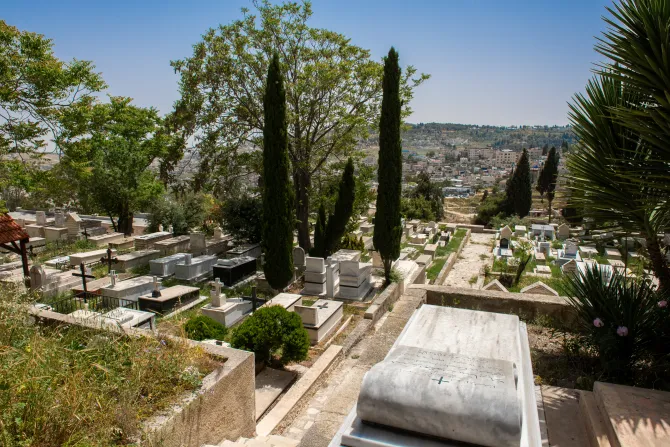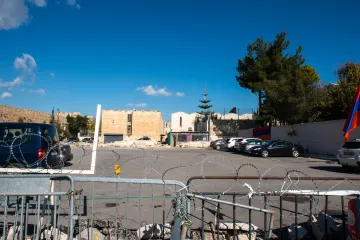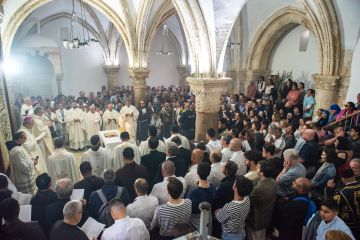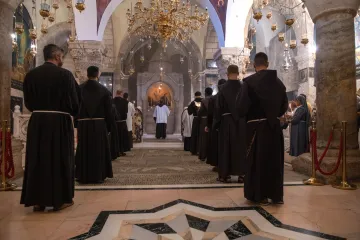Jerusalem, Apr 27, 2024 / 07:00 am
This past February, the Custody of the Holy Land filed a petition in the Jerusalem District Court against the confiscation of a piece of land inside the Catholic cemetery, which is located on the southern hillside of Mount Zion and serves as a parish cemetery.
The affair is part of a project to build a cable car running from First Station (the shopping and entertainment area in West Jerusalem) to the Old City’s Dung Gate (the main access to the Western Wall and close to the City of David archaeological site), passing over the Hinnom Valley (or Geenna). The cable cars would be strung over some 15 pylons, from about 30 to 85 feet high, and would ferry up to 3,000 people per hour in up to 72 cars that can each hold 10 people.
The Jerusalem Development Authority (a joint agency of the government and the Jerusalem Municipality), which is responsible for the project, is exploring the opportunity to use the piece of land in the cemetery to place a cable car support pylon.
The Custody of the Holy Land fears that the cable car may pass over the cemetery, a detail that had been ruled out during a preliminary meeting in 2017, as evidenced by a protocol that CNA was able to view. Relying on that premise and promise at that time, the custody did not exercise its right to object to the project.
However, on Christmas Eve 2023, everything changed. A planning notice by the Jerusalem Local Planning and Building Committee of the Jerusalem Municipality was found on a pylon close to the cemetery announcing that that piece of land was going to be temporarily confiscated (for at least eight years).
According to Eliana Touma, an attorney and legal adviser of the Custody of the Holy Land, who was contacted by CNA, “the custody didn’t receive any kind of formal notice from the Jerusalem Local Planning and Building Committee.”
The area subject to confiscation (not yet effective) is situated on the northeast side of the cemetery. It is the oldest part of the cemetery, where there are some graves of British soldiers from the time of the British Mandate in Palestine. These graves would need to be removed and relocated if the construction of the cable car pylon were to proceed. This risks turning a local dispute into an international case.
Also in this area is the sarcophagus of Francesca Barluzzi, sister of architect Antonio Barluzzi, who designed some of the famous holy sites in the Holy Land cared for by the custody. This year marks the centenary of two of them: the Basilica of the Transfiguration on Mount Tabor and the Basilica of Agony in Gethsemane.
In this same cemetery, in the more modern section, is the burial place of Oskar Schindler, one of “righteous among the nations,” who is credited with saving the lives of more than 1,000 Jews during the Holocaust. The grave is visited by many Jews and is almost completely covered by stones.
According to Touma, “the lawyers of the custody met the representative of the Jerusalem Development Authority at least three times in January and February before submitting the petition,” and “a tour at the cemetery was done in February, to show them that in that area there are the graves of the British soldiers.”
After nothing came of these meetings, the Custody of the Holy Land filed a petition in the Jerusalem District Court, a legal action that must be undertaken when a decision from the state or any other governmental office is believed to have damaged the subject in any way.
“It’s no longer possible to oppose the plan because the deadlines for doing so have expired, and we have relinquished our opposition based on what was promised to us,” Touma explained to CNA. “At the moment, the only option we have is to oppose the confiscation, and that’s what we’re doing with this petition.”
The petition was filed against the Jerusalem Development Authority, the Municipality of Jerusalem, and the Local Planning and Building Committee of the Jerusalem Municipality. The court gave the respondents until June to respond to the petition (and reach an agreement). A first hearing is scheduled for Sept. 16.
According to Touma, the petition’s main arguments are threefold.
First, the Custody of the Holy Land claims that authorities have broken the promise made in 2017 not to run the cable car over the Franciscan cemetery on Mount Zion.
“Discrimination” is another important argument: “Lands owned by the state and used for public purposes that have been leased by the Israel Land Authority cannot be confiscated, while the land owned by the Church is going to be confiscated even though it is used for public purposes [cemetery].”
(Story continues below)
The accusation of discrimination is particularly loaded with meaning in a social and religious context like this one. In using this argument, there’s a growing sense among Christian churches that they are being targeted by Israeli institutions. The attack on properties would ultimately be nothing but a threat to their existence, carried out with different arguments whenever the opportunity arises.
The third argument concerns the nonnecessity of the land confiscation itself.
“According to previous judicial decisions,” Touma told CNA, “in order to confiscate land, it is necessary to demonstrate that the specific part of land is really needed and essential for the project. This justification was not provided.”
A land confiscation is the toughest and most extreme action of an administration and the Custody of the Holy Land considers it “not proportionate, not reasonable, and not just at all.”
“We must stop it, especially when we have the legal right and opportunity to do so,” Touma said. “We must take proactive steps to prevent any interventions that could dramatically affect the churches. It’s essential to establish clear boundaries and to make it unequivocally clear that we will not remain silent.”
Speaking to CNA, the custos of the Holy Land, Father Francesco Patton, lamented “the continuous assault on the Holy City by constructions and changes to the landscape, which sometimes even damage or expropriate Church properties.”
The fact that the confiscation of a cemetery area is at issue “aggravates the situation because traditionally, these areas are the most respected in the Holy Land,” he continued. “The issue of cemetery areas deeply touches the sensitivities of Jews, Muslims, and Christians alike. Wherever there are cemetery areas, they should be protected as much as possible.”
There is also another cemetery, belonging to the small Karaite community, a Jewish religious denomination, considered by some a sect, originating in Mesopotamia in the early eighth century, that is affected by the project. Its cemetery is located on the opposite side of the Hinnom Valley from the Catholic cemetery, on the slope beneath the Abu Tor neighborhood, opposite Mount Zion. The cable car would pass directly over it, and the community has objected to the project.
However, the high court dismissed the objections by the Karaite community, saying that if the Jerusalem authorities moved it, it would pass over the Catholic cemetery, which wasn’t possible due to their agreement with the Custody of the Holy Land. The fact that the promise to the custody is mentioned in a court ruling may strengthen the custody’s position.






